Dave and Dianne Rankin from Oregon
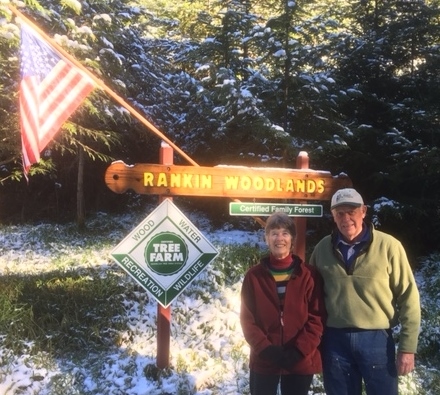 What Makes Them Outstanding?
What Makes Them Outstanding?
Dave and Dianne Rankin became actively involved in forestry after retiring from a long career as educators. They purchased Rankin Woodlands in 1973 as a nice place to build a home and raise two sons. That purchase started decades of passion and appreciation for their forests and all the values associated with it, as well as a desire to educate others about those values. Today, the Rankins actively manage their working forest with a focus on all the values recognized in the American Tree Farm System (ATFS). The original focus was on protecting the ecological values of their forest. Over time they realized the forest could also provide sustainable income while still protecting all the ecological values. They plan timber harvests with good timber markets. Dave has a portable sawmill to also mill lumber. He does much of the logging himself. They maintain a good balance between environmental, economic, and social values of a tree farm. For years, the Rankins have hosted student field trips, Oregon State University Forest Extension programs, landowner woods tours, and participated in Watershed Council activities in the Siuslaw Watershed. They look for opportunities to host tours and spread the word about sustainable forest management. They have a solid commitment to their community and the state organizations to which they belong. It is rare when Dave or Dianne are out in Florence that they are not approached by a former student or friend, many who have visited Rankin Woodlands.
Tree Farmer Story
Dave and Dianne Rankin moved to Florence in 1963. Both worked in the education profession; Dave as a teacher, counselor and administrator and Dianne as a teacher and librarian. In 1973, the Rankins partnered with friends to purchase 184 acres of forestland which were divided equally shortly thereafter. They had no experience in managing a forest, but they purchased the property with a vision for the future. To them this property was a jewel, an heirloom gem that they wished to keep in the family for generations. They began to preserve and manage the former naturally reforested commercial timber lands with conservation of its valuable resources; water, soil and forest in mind. They built a home and raised two sons. With Daveís building expertise and help from friends the home was built in 15 months.
Back then materials could be salvaged from the beach. Salvaged Western Red Cedar and Redwood logs became paneling, cabinets and a front door and salvaged timbers now support an interior open stairway. The home is heated with firewood from the forest.After they retired in 1992 and spent six years traveling around the world in a 38 foot sail boat, they began to focus on the opportunities their forest provided to them. They realized their forest could also be managed sustainably to generate income. Dave took some forestry training through Oregon State University Forestry Extensionís Master Woodland Manager Program.
In 1999 they joined the American Tree Farm System and the Lane County Chapter of the Oregon Small Woodlands Association. That year also saw the beginning of Rankin Woodlands as a small business. Since then, Rankin Woodlands has been an active working forest. After researching and much thought, in 2005 the small business became Rankin Woodlands Limited Liability Company. Dave and Dianne are an outstanding example of small woodland owners who have made the commitment to live on the land, maintain its environmental values, sustainably produce and sell timber products, and share with the community the values of sustainable forest management.The Rankins have never lost the desire to teach and shape opinions.
They continue to be involved in organizations that foster their passion for their forested property with a focus on the big picture, finding the balance of values in owning forestland. They want to share their natural resources experiences with students. Dave believed that a Forest Field Day sponsored by Forests Today and Forever, a non-profit organization dedicated to teaching natural resource values to grade school students in Lane County, would benefit the sixth grade students in Siuslaw and Mapleton Schools.
The sponsors agreed, and for 10 years he coordinated local forest oriented volunteers to lead the four topics of concern: Timber, Wildlife, Recreation, and Soil and Water. Dave and Dianne also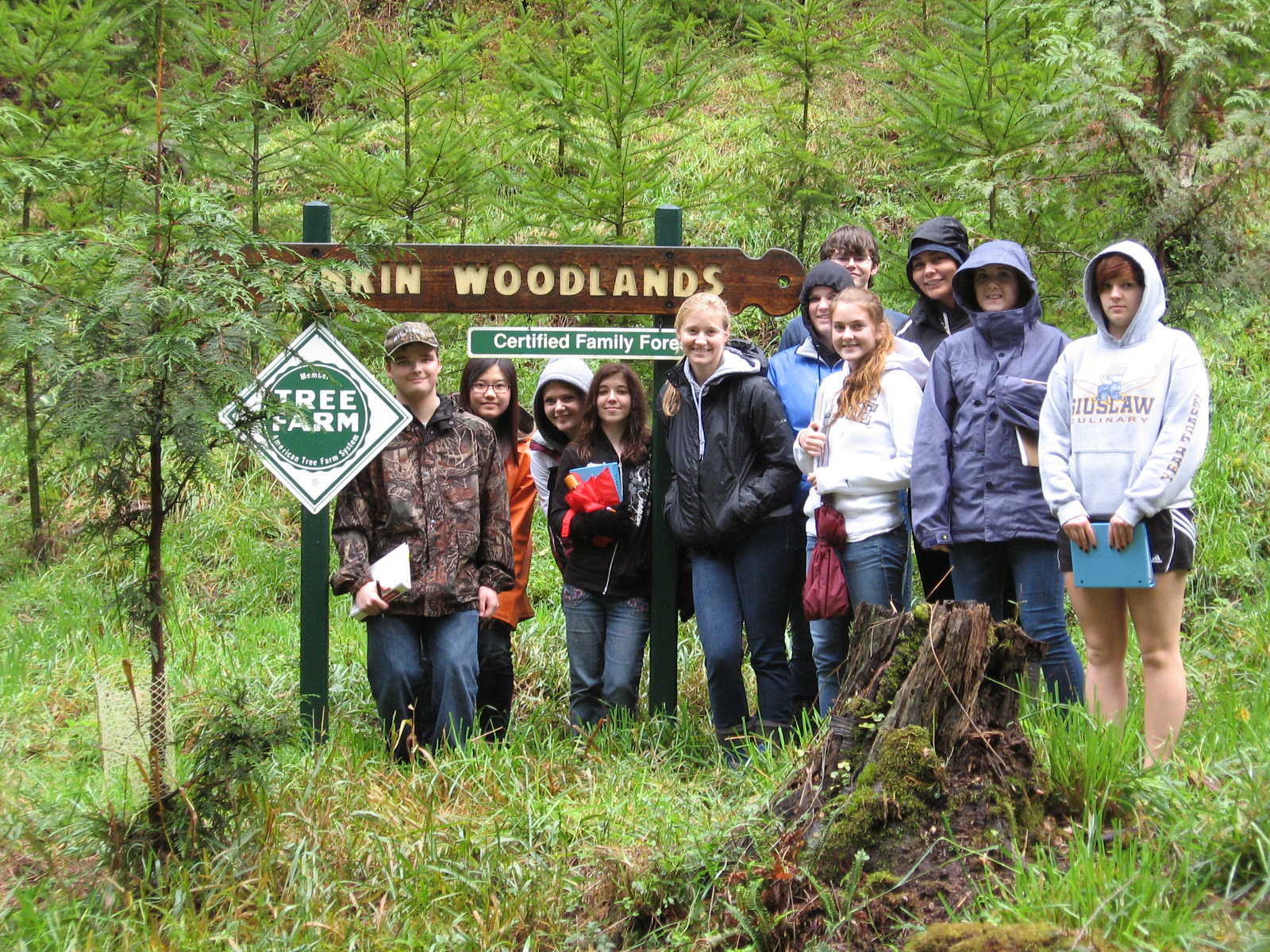 annually host students from Siuslaw High School's Field Study Class on a tour discussing Forest Ecology and Hydrology. Siuslaw Watershed Council Summer Student Campers have visited Rankin Woodlands, constructed Wood Duck Nesting Boxes and hiked to a fresh water pond to observe wildlife. Adult and professional tours have focused on Red Alder, Its Habitat and Economic Value, Basal Area, Coastal Riparian Concerns, and Thinning techniques and philosophies.These programs demonstrate the many aspects of managing forests in Oregon.
annually host students from Siuslaw High School's Field Study Class on a tour discussing Forest Ecology and Hydrology. Siuslaw Watershed Council Summer Student Campers have visited Rankin Woodlands, constructed Wood Duck Nesting Boxes and hiked to a fresh water pond to observe wildlife. Adult and professional tours have focused on Red Alder, Its Habitat and Economic Value, Basal Area, Coastal Riparian Concerns, and Thinning techniques and philosophies.These programs demonstrate the many aspects of managing forests in Oregon.
Their focus is always on the triple bottom line, managing to protect the environmental values of a forest, the economic assets of a working forest, and the social and community benefits of understanding the values of sustainable forest management. Through their hard work and dedication, the Rankins are recognized in their community, county, and state as thoughtful and committed family forest owners who are willing to go the extra mile needed to promote what they believe in, being a responsible forest steward. It is common for a past participant to comment about the good time they had on Rankin Woodlands.Using his mechanical and building skills, Dave set up a covered structure to house two portable sawmills which produce lumber and timbers from the oversized and defective logs from their forest. Lumber and timbers that are not used on site are sold on site or through local lumber suppliers. On site he has built an addition to their home, out-buildings for storage of equipment and wood products and retaining walls.
Rankin Woodlands has also donated lumber to the local Habitat for Humanity Restore and Siuslaw Schoolís woodshop class. Wood-Duck nesting boxes, bat houses, rustic wooden benches and cut and delivered firewood have been donated for local fund raising projects for Oregon Small Woodlands Association, Forests Today and Forever, Siuslaw Watershed Council and Siuslaw High School Athletic Boosters. The Rankinís door is always open to support a cause consistent with their commitment to their community and the principles of sustainable forest management.In 1995 and 2011, Dave and Dianne purchased all of the 92 acre half-portion of the original property that had been deeded to their friends back in 1973. It had changed ownership several times since 1973. The previous owners had managed the property intensively for timber production. It had been harvested in 1989 and replanted in 1991.
Under the Rankin Woodlands management, this property is managed as a working forest, with a focus on all the values recognized in the ATFS. This even aged predominantly Douglas-fir 26 years old stand will provide the Rankin Woodlands with some great opportunities to practice sustainable forestry following the Rankin forest management strategies. They live the values found in the American Tree Farm System. Their hearts are in their forest with their feet in the mud on the ground and sharing their experiences with others. They are truly outstanding Oregon Tree Farmers.
Wood
Rankin Woodlands is a working forest, generating income from the harvest of trees and the 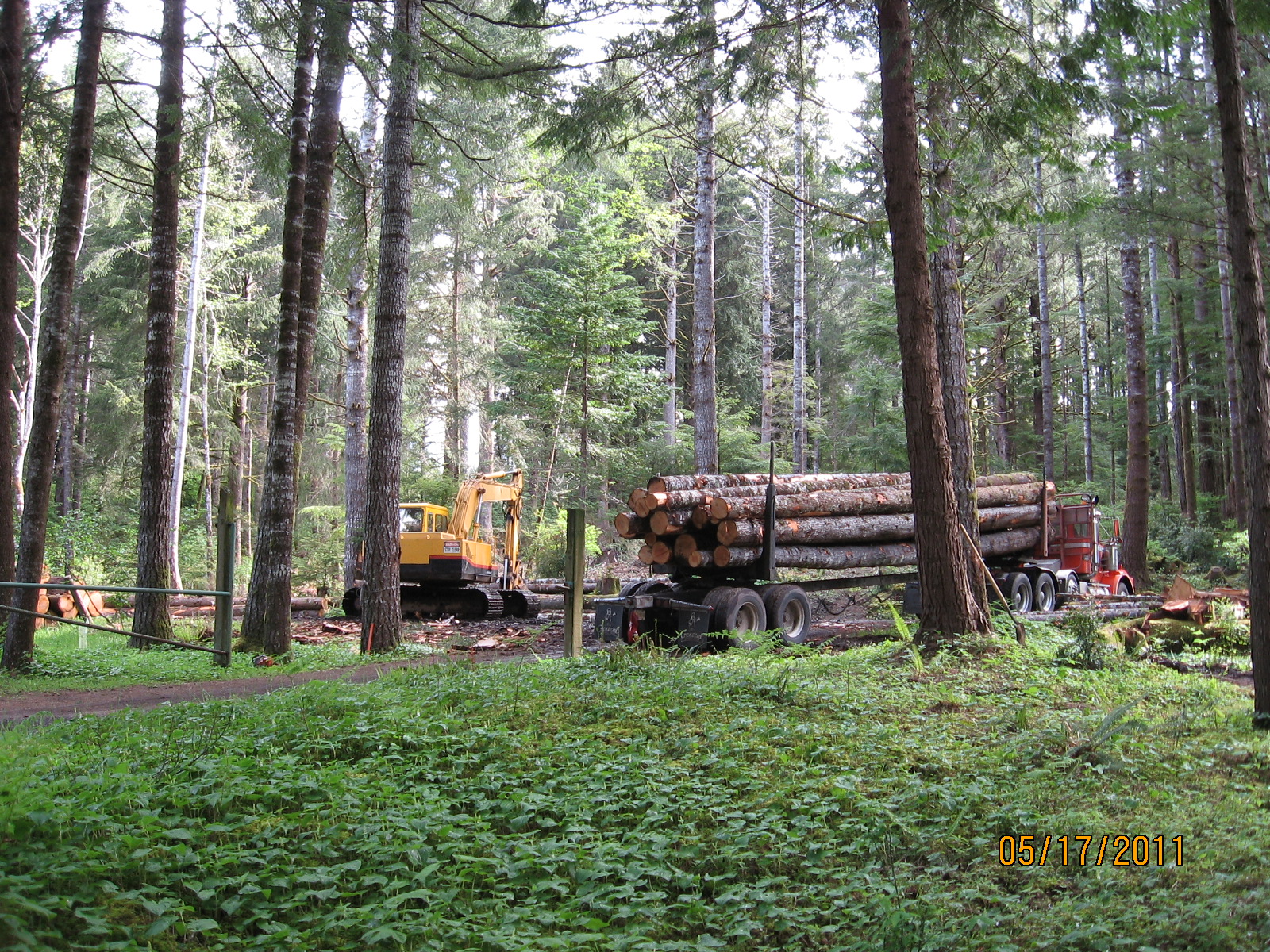 manufacturing of lumber. The forest has a variety of tree species natural to the Coast Range of Oregon; Douglas-fir, Sitka Spruce, Western Hemlock, Western Red Cedar, and Red Alder. Harvests take place when markets are up for the primary species being harvested. Trees with good local markets are sold as delivered logs. Oversized and unmerchantable logs are converted to lumber, timbers, posts and firewood on site using a milling process developed by Dave.
manufacturing of lumber. The forest has a variety of tree species natural to the Coast Range of Oregon; Douglas-fir, Sitka Spruce, Western Hemlock, Western Red Cedar, and Red Alder. Harvests take place when markets are up for the primary species being harvested. Trees with good local markets are sold as delivered logs. Oversized and unmerchantable logs are converted to lumber, timbers, posts and firewood on site using a milling process developed by Dave.
Lumber is sold for homeowners use or conversion to a higher valued product. Lumber is also donated to Habitat for Humanity ReStore and Siuslaw Schools woodshop class.In their management strategy, existing mature stands of mixed species have been upgraded by selective removal of spruce, hemlock, alder, to enhance the growth of Douglas-fir, the highest valued species in the area. Most of the harvest activities are done by Dave with the exception of a 20 acre clear cut in 2014 requiring a sophisticated yarding system. The Rankins have selectively harvested Red Alder with a ground yarding system along main roads. They have also selectively harvested mixed species around the home site. Even-aged management is the primary management strategy, but portions of the property are managed using uneven aged. The mix of natural tree species will be maintained.Some stands are approaching the age for a commercial thinning. There has been some limited pruning along roads and structures.
Pruning following a commercial thinning is being evaluated for future activities. Harvested areas are either planted with Douglas-fir, Red Cedar, or Coastal Redwood seedlings. Western Hemlock, Sitka Spruce, and Red Alder naturally reseed in the forest. The 2014 clearcut of 20 acres was replanted with 6,000 Douglas-fir and 1,000 Western Red Cedar seedlings.
Water
On Rankin Woodlands, 35 acres are greatly influenced by water. There are approximately 4600 lineal feet of frontage on South Slough Inlet. These tidal influenced lands are zoned Natural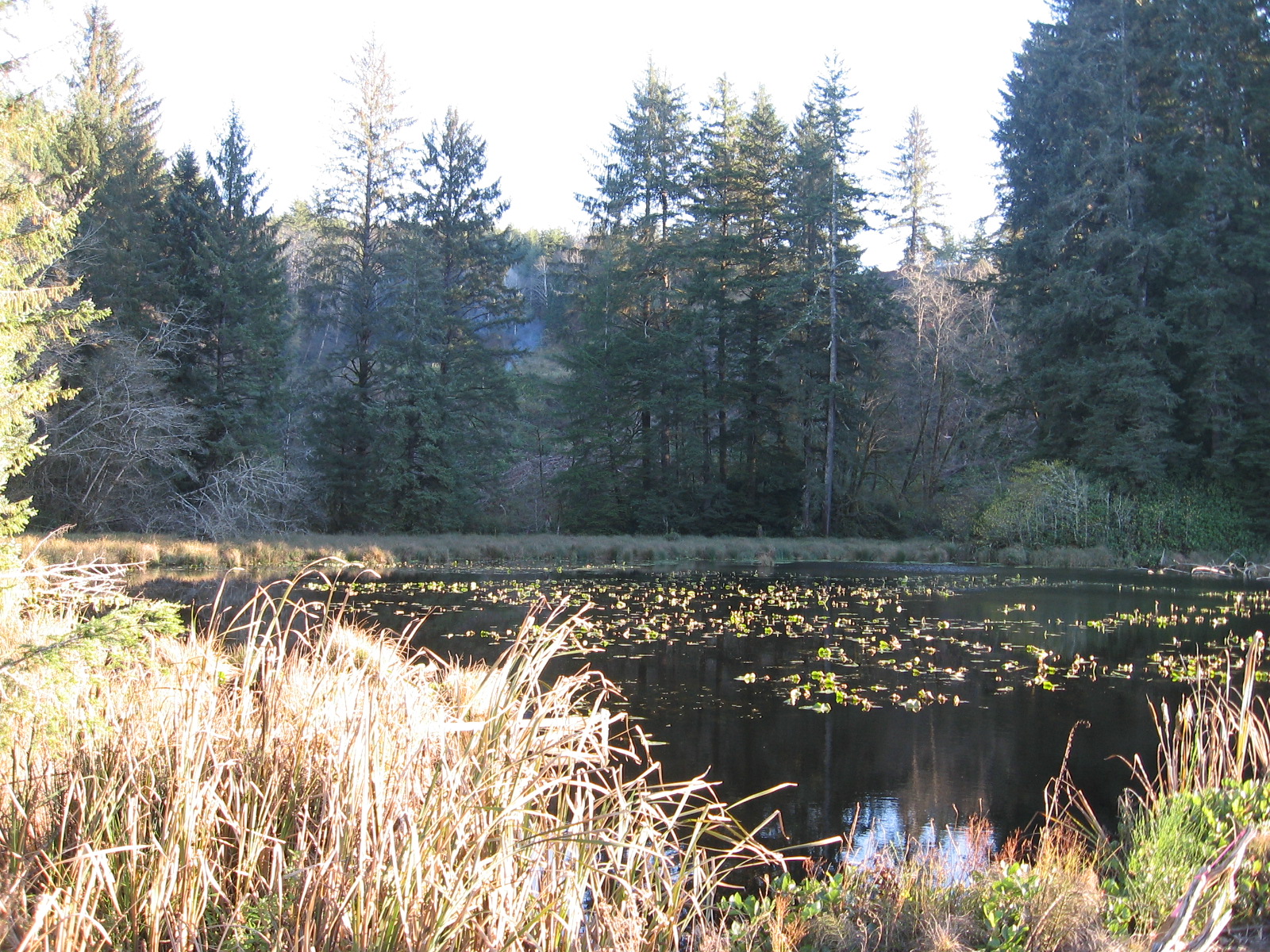 Estuary. Every day the tidal waters from the Pacific flow in and out of the Inlet providing nutrients and minerals to this estuary system. The importance of estuaries for habitat of multitudes of wildlife species has been well established by scientific studies. Runs of winter Steelhead and fall Chinook are endemic to this ecoregion. Dave and Dianne provide forested buffers around the estuary to protect this unique ecosystem. For their 2014 clearcut the Riparian Management Plan (RMP) for the uplands provides a 120 no touch buffer which leaves a solid buffer of understory vegetation, snags, down wood and live trees with no damage to the soil and hydrologic functions.There are two streams that run all year.
Estuary. Every day the tidal waters from the Pacific flow in and out of the Inlet providing nutrients and minerals to this estuary system. The importance of estuaries for habitat of multitudes of wildlife species has been well established by scientific studies. Runs of winter Steelhead and fall Chinook are endemic to this ecoregion. Dave and Dianne provide forested buffers around the estuary to protect this unique ecosystem. For their 2014 clearcut the Riparian Management Plan (RMP) for the uplands provides a 120 no touch buffer which leaves a solid buffer of understory vegetation, snags, down wood and live trees with no damage to the soil and hydrologic functions.There are two streams that run all year.
One provides water to the house and empties into a small lake (<8 acres). There are fish in this lake, but the gradient of the stream does not allow any fish to go inland much past the lakes 50 buffer. Above the point of diversion for the domestic use the Rankins and the abutting landowners agree to a no touch buffer on both sides of the stream in excess of 50. The second is a fish bearing stream with a Riparian Management Area of 50 on each side until the gradient exceeds 20% for over 30 feet.The site prep before the February 2016 planting required an application of herbicide during the summer of 2015. No spray was applied along the banks of either the running streams or the dry streams leaving the vegetation intact. Road work after the 2014 clearcut included the replacement of 5 culverts, kept clear for proper drainage.
Wildlife Including Threatened and Endangered Species
Wildlife is abundant on Rankin Woodlands. Three years after purchasing the property in 1973, Dave 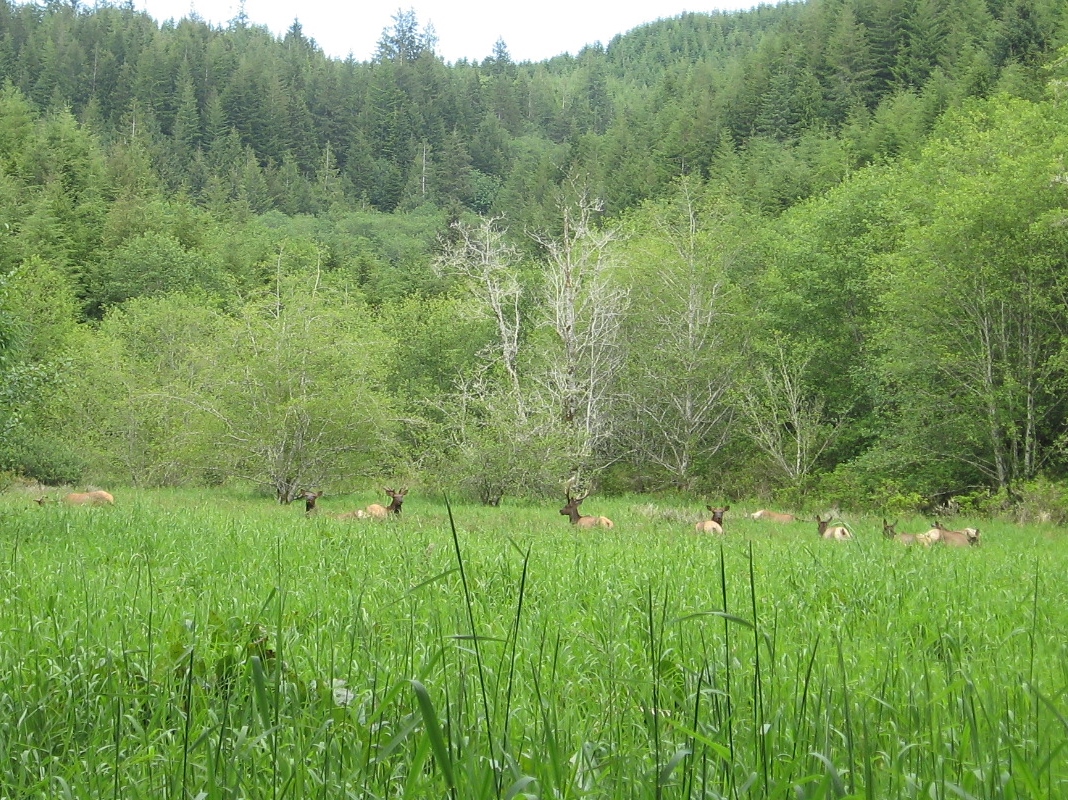 completed the house and the family moved into their new home. Every day they were able to see up-close and personal deer, bears, bobcats, coyotes, rabbits, beavers, squirrels, chipmunks, opossums, and raccoons. Favorite birds include Western Tanager, Ruffed Grouse, Great Blue Heron, Snowy White Egret, Pileated Woodpecker, Osprey, Red Tailed Hawk, Winter Wren, Rufous Hummingbird, Stellerís Jay, Barred Owl, Greater Yellow-legs and Band-tailed Pigeon. Ducks, song birds, sea birds, and vultures visit seasonally as they migrate along the Pacific Coast. Harbor seals, otters and schools of herring and candle fish frequent the tidal waters.Today, Roosevelt Elk, Bald Eagles, and Canadian Geese have been established. Neighboring forest plots have been harvested, young open forest stands have come and gone, middle-aged stands are present, and currently Rankin Woodlands older forest stands are being harvested.
completed the house and the family moved into their new home. Every day they were able to see up-close and personal deer, bears, bobcats, coyotes, rabbits, beavers, squirrels, chipmunks, opossums, and raccoons. Favorite birds include Western Tanager, Ruffed Grouse, Great Blue Heron, Snowy White Egret, Pileated Woodpecker, Osprey, Red Tailed Hawk, Winter Wren, Rufous Hummingbird, Stellerís Jay, Barred Owl, Greater Yellow-legs and Band-tailed Pigeon. Ducks, song birds, sea birds, and vultures visit seasonally as they migrate along the Pacific Coast. Harbor seals, otters and schools of herring and candle fish frequent the tidal waters.Today, Roosevelt Elk, Bald Eagles, and Canadian Geese have been established. Neighboring forest plots have been harvested, young open forest stands have come and gone, middle-aged stands are present, and currently Rankin Woodlands older forest stands are being harvested.
As the forestlands change with management, the wildlife adjusts to the new environment. Native fruit producing bushes and trees are encouraged to grow amongst the existing conifers. When trees and bushes are pruned or thinned or a tree falls, the debris is stacked and left for wildlife cover.Prior to their 20 acre clearcut in 2014, the Rankins evaluated their property. They determined approximately 35 acres are greatly influenced by bodies of water; 18 are tide lands, 4 are unsuitable for growing commercial timber and approximately 13 are riparian in nature. They also decided that a 10 acre parcel they call Big Spruce Flat will be managed as a multiple species/multiple layered stand. These 45 acres are managed for wildlife and recreation.
Recreation and Aesthetics Including Special Sites
There are many recreational opportunities on Rankin Woodlands. The Rankins have their favorite hiking trails used by themselves and guests. Walking along the railroad tracks that traverse the western border of Rankin Woodlands separating the forest from the tidal lands to the clam beds at the north west corner of the property is worth the effort even if the clams happen to be few and far between. When the clams are there and the sun is shining, it is a wonderful experience. Growing up the two sons with their friends were avid duck, pigeon and deer hunters. Now Grandson Henry and his dad carry a camera, clam shovel, binoculars, fishing pole, and in hunting season a firearm.
The Siuslaw High School Field Study Class annual visit to Rankin Woodlands not only provides an educational experience on Forest Ecology and Hydrology, but also is a great recreational experience. Often they spend some time hunting for Chanterelles which their teacher cooks for them when they return to the classroom. A couple of times they were entertained by a resident Ruffed Grouse. Students pass the word about the experience, and later class participants look forward to the opportunity.The natural views of the slough and mixed species forests can be spectacular for family and visitors.
One of Dave and Dianneís goals is to build a viewing platform on a high spot from which they will be able to see the Pacific Ocean and on nice days enjoy a picnic. The beauty of the Rankin Woodlands is one of its valuable assets. The Rankin Woodlands are not visible from any public road, however if it were viewers would see a well-managed working forest with a variety of forest ages, forest conditions, meadows, ponds, and a beautiful estuary that adjoins the property.


